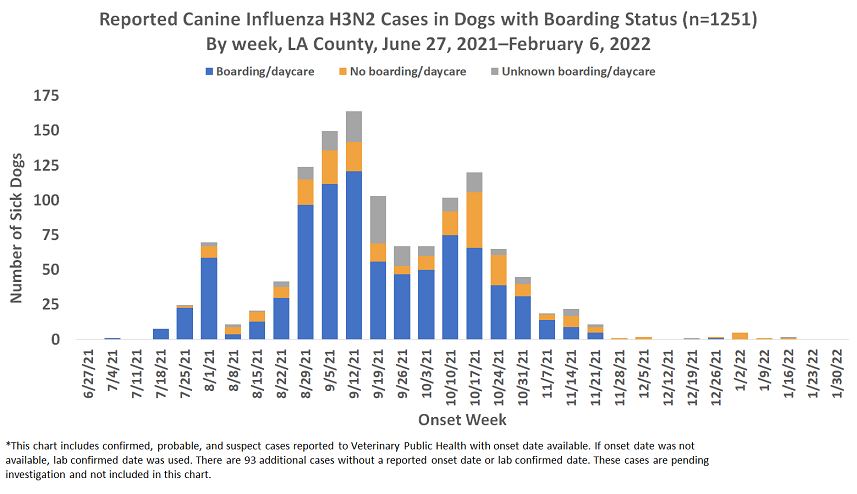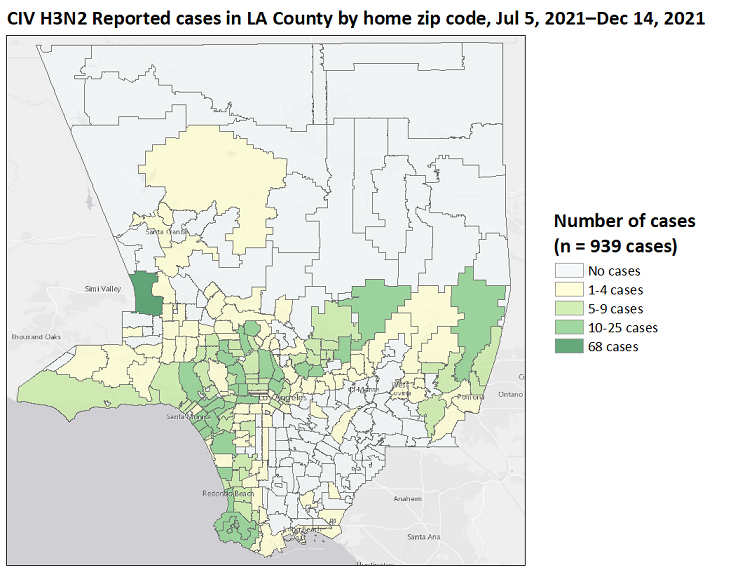| H3N2 canine influenza in Los Angeles County |
VETERINARIANS
- Please report cases of
Canine Influenza
here
Download our Canine
Influenza H3N2 handout -
English Espaņol
Espaņol
Overview of Canine influenza H3N2

The canine influenza virus H3N2 (CIV
H3N2) usually causes mild
to moderate
disease in dogs and on rare occasions can also infect cats.
This strain of canine influenza was first found in the US in
2015 when it was detected in Chicago and spread to other parts of the
country.
Infected dogs are contagious to other
dogs 2 days
before the start of clinical signs, and for at least 21 days or
more afterward, even after they appear healthy.
In August 2017, the Veterinary Public Health Program (VPH) learned
from The College of Veterinary Medicine at the University of
Wisconsin that some infected dogs may shed the
virus for 30 days or more. Transmission of influenza usually occurs
through contact with infected respiratory secretions
(e.g. coughing, sneezing) as well as from contamination of the
environment (e.g. bedding, floors, bowls, collars, leashes). To date, there is no evidence that humans
can become sick with
canine influenza H3N2.
When CIV H3N2 cases occur locally, VPH's goal
is to stop the spread of the virus to protect the animals of
our county. The most effective tool in stopping the spread
is home isolation of sick dogs for 28 days from the first
day of illness and a 14
day quarantine for exposed dogs (to see if they will develop
symptoms). VPH strongly recommends that dogs be vaccinated
against CIV H3N2 before they enter boarding kennels, dog day
care, dog parks, or engage in dog group activities.
This vaccine is also advisable for dogs that may
occasionally encounter other dogs.
Outbreak of Canine
Influenza H3N2 cases in Los Angeles County
July 2021 - January 2022 -
Outbreak in dogs throughout Los Angeles County
Between July
2021 and January 2022, 1344 total reported cases of CIV H3N2
in dogs in LA County were reported to Veterinary Public
Health. This was the largest outbreak of CIV H3N2
reported in LA County. Of the cases reported with
known exposure, 85% (972/1146) were associated with
attending boarding kennels, dog daycare settings, or
shelters. The virus spread rapidly among dogs
throughout LA County, affecting at least 68 congregate
facilities and 2 animal shelters. Each facility was
contacted, either in person or via phone and email, and
given recommendations on how to control the spread.
15% of the reported cases never visited a boarding or
daycare facility but were exposed in settings including
walks in their neighborhoods, dog parks, groomers, and
veterinary clinics. Sadly, 21 deaths were associated
with this outbreak. To stop the spread of the
outbreak, pet owners and veterinarians were strongly
encouraged to vaccinate dogs against CIV H3N2 and to isolate
sick pets at home for 28 days from the first day of illness.
Pets exposed to confirmed or suspected cases were advised to
be kept quarantined at home and observed for clinical signs
for 14 days.
Is it still recommended to have my dog vaccinated for Canine
Influenza?
Yes. It
remains important that dogs are fully vaccinated against CIV
H3N2 before they enter boarding kennels, dog daycare, dog
parks, or engage in dog group activities. This
vaccination is also advisable for dogs that may occasionally
encounter other dogs. The importation of dogs and
puppies from canine influenza endemic areas remains constant
throughout the year. Given how quickly the virus
spreads and how long dogs are contagious to others, the risk
for dogs in LA County to contract the disease will always be
present. Dogs are considered fully vaccinated when at
least 14 days have passed since the last booster was
administered. The CIV H3N2 vaccine decreases the
severity of clinical disease and viral shedding but does not
prevent against infection. Therefore, herd immunity in
the dog community is important for outbreak control.
The epidemic curve for this outbreak with information about
boarding/daycare status is below:


Recommendations
Pet owners
-
If your pet has symptoms
of influenza, keep it away from other animals
and contact your veterinarian.
-
Symptoms of influenza may
include: cough, fever, sneezing, discharge
from the nose, lethargy, and/or loss of
appetite. Some dogs have no symptoms.
-
Vaccinate dogs against
CIV H3N2 before they enter
boarding kennels, dog day care, dog parks,
or engage in dog group activities.
This vaccination is also advisable for dogs
that may occasionally encounter other dogs.
-
The CIV vaccine
is two doses, given 3-4 weeks apart.
To provide time for immunity to develop,
dogs should wait 2 weeks after receiving the
second dose of the vaccine before entering
facilities or having contact with other
dogs.
-
Canine Influenza & Leptospirosis Vaccine
Providers in Los Angeles County  and
Neighboring Counties
and
Neighboring Counties 
-
If your pet is sick, keep
your pet at home for 28 days from the first
day of illness - this will help to prevent
your dog from spreading the disease to other
dogs even after they are fully recovered.
-
If your pet is
asymptomatic but was exposed to other sick
pets, keep your pet at home for 14 days to
monitor for symptoms and then contact your
vet if they become ill.
-
To prevent spread of
disease, do not let a sick pet share its
food bowl, leash, toys, or other supplies
with other pets
-
Wash your hands after
touching your pet
Veterinarians/Animal workers
-
Do not allow coughing dogs
into your common spaces in your practice
(lobby, shared treatment room or kennel
space, etc.). Move them immediately
into an exam room, or (if not hot
outside), have the owner wait in the car
with their coughing dog.
-
In any case with a
coughing dog, ask about the health of the
dogs that spend time near the coughing dog,
to determine if there may be an outbreak.
Advise the owner to keep the coughing dog at
home.
-
Dogs that interact with
other dogs (e.g. boarding, daycare, dog
park, groomer) should be vaccinated against CIV
H3N2
-
Isolation and quarantine
-
Report any suspected or
confirmed cases of influenza in dogs or cats
to VPH using this
reporting form.
-
If a case is suspected,
use proper isolation measures to prevent
infection via direct contact or fomites
-
Recommendations for
disinfection and biosecurity available
here.
-
Canine Influenza Posters for Veterinary
Clinics 
Archived Materials
These materials were used during the
outbreak and may have outdated information as the outbreak
has since ended.
More Information
Canine Influenza - Los Angeles County Department of Public
Health
Canine influenza (Dog Flu) - Centers for Disease Control and
Prevention (CDC)
Canine Influenza - American Veterinary Medical Association
(AVMA)
Outbreak of Canine Influenza H3N2 in the San
Francisco and Bay area in Northern California Jan-Feb 2018
Historic
Canine Influenza H3N2 Cases in Los Angeles County
March 2018 -
Single case in a dog imported from South Korea
In mid-March 2018, a group of 3 dogs were
imported from South Korea. One of the 3 had
ocular and nasal discharge, and tested PCR
positive canine influenza H3N2. The sick dog was placed
into 40 days of home isolation, and the 2
exposed dogs were placed in a 14 day home
quarantine. An additional dog on the same flight
was also quarantined at home for possible
exposure.
January 2018 -
Single case in a dog in the South Bay area
In late January 2018, a dog in the South Bay
area became ill with cough, fever and loss of
appetite. The dog tested PCR positive for canine
influenza H3N2 by PCR. The source of the
infection is unknown, and no evidence of an
outbreak was found.
November 2017 - Single case in a dog in the San Fernando Valley
In early November 2017, a veterinarian in
the San Fernando Valley
area reported that a dog with moderate coughing and mild
sneezing had tested positive for canine influenza H3N2 by PCR.
The dog had been at a grooming facility during the week before illness, but had no other reported contact with dogs.
The dog was placed in home isolation for 40 days, and an investigation was performed.
Veterinary practices and animal-related businesses in the
immediate area were contacted to find out if they were also
seeing cases. There was no evidence of a larger outbreak.
August 2017 - Outbreak in 27 dogs in the San Gabriel Valley
In early August 2017, VPH was notified
that a dog in the San Gabriel Valley tested positive for
canine influenza H3N2 by PCR. The dog developed a mild cough
in late July after boarding
at a local kennel. The veterinarian had tested the dog for
influenza 2 days later.
VPH worked closely with the boarding
facility to contact owners of dogs that were present during
the second half of July 2017. At least 26 other dogs developed
respiratory-like illness. Only three of these 26 dogs were tested
for canine influenza by PCR, and all three were negative. Note that a
negative PCR test does not rule out infection, since
infected dogs can shed the virus intermittently. During this
investigation, VPH learned from the University of Wisconsin
that dogs infected with this virus may potentially be
contagious for 30 days or longer (unpublished data).
Therefore, dogs that had been ill were placed under home
quarantine for 40 days after the onset of illness. Healthy animals that
had been exposed to the
sick dogs were quarantined at their
homes for 14 days after last
potential exposure. All of the sick dogs
recovered and the outbreak resolved. The source of this
outbreak was unknown. No direct link was found with the single case in
May imported from Asia, however, since they both occurred in the San Gabriel Valley,
it is possible that they may have been connected.
May 2017 - Single case in a ill dog imported from Asia
to the San Gabriel Valley
In May 2017, a single dog imported from Asia was found to have fever and pneumonia soon after arrival.
The dog was taken to two veterinary practices in the San Gabriel Valley area of Los Angeles County. It was kept at home
until it appeared healthy, but was not isolated for 40 days.
After it appeared healthy, it was taken to local dog parks. This case was not reported until August 2017,
three months after the dog's illness.
April 2017 - Single case in a dog from San Bernardino County
In April 2017 VPH was notified of a single dog
that had tested positive for canine influenza H3N2. The dog had been ill very early in
March when it was brought from San Bernardino County into Los
Angeles
County. The dog had been kept in isolation
for 2 weeks before being placed in a facility with a large
group of dogs. VPH worked closely with the large facility to
check for further spread of the virus.
Very few dogs in the facility were coughing, suggesting that
influenza was unlikely to have been on site. With the help
of the College of Veterinary Medicine at the University of
Wisconsin, VPH performed PCR testing on 10 of the 91 dogs in
the facility for influenza - all 10 were negative.
Sixty-nine of the 79 dogs that had been in the facility in
March and April were located. Most were healthy, but 14 had
developed some coughing. Three of the 14 were serologically
tested for exposure to canine influenza H3N2 and were
negative, showing they had not been exposed to the virus.
The Veterinary Public Health Unit of the
San Bernardino County Department of Public Health assisted
in the investigation by visiting two locations where the
sick dog had spent time in that county, and found no
evidence of any respiratory outbreaks in dogs.
March 2017 - Outbreak in 35 dogs, most imported from Asia
In March 2017, a local veterinarian
reported a potential outbreak of canine influenza H3N2 in
dogs imported from Asia. The dogs showed signs consistent
with influenza such as coughing, sneezing, fever and nasal
discharge. During the initial investigation, laboratory
testing by polymerase chain reaction (PCR) confirmed the virus in two dogs.
After a prolonged investigation, a total of
52 dogs
exposed to the virus were identified, including 35 sick
animals. Of the 35 sick dogs, the virus was
confirmed by PCR in 6 dogs and suspected in the other 29
dogs. A total of 62 dogs were
placed under quarantine or isolation in 17 locations. The 62
dogs included the 35 sick dogs, plus 17 that were exposed
but did not become sick, plus 10 that were living with the
exposed but healthy dogs. It is likely that home quarantine
played a significant role in helping to limit the size of
the outbreak.
Two
sick dogs died, however both had been suffering
from other unrelated illnesses. Ultimately, all of the other
sick dogs have recovered and were released from
isolation. The College of Veterinary Medicine at the
University of Wisconsin provided assistance by testing samples from several dogs.
Samples were submitted to
veterinary virologists in order to compare this virus to the
canine influenza H3N2 virus that caused a large
outbreak in the Chicago area in 2015.
Last updated: July 19, 2022